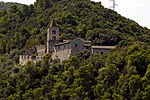Bridge of Augustus (Narni)
Bridges completed in the 1st century BCDeck arch bridgesRoman bridges in ItalyRoman sites of UmbriaStone bridges in Italy

The Bridge of Augustus (Italian "Ponte d’Augusto") is a Roman arch bridge in the Italian city Narni in Umbria, built to carry the Flaminian Way over the river Nera. Of the original four spans of the 160-metre-long (520 ft) bridge, only the southernmost remains standing.
Excerpt from the Wikipedia article Bridge of Augustus (Narni) (License: CC BY-SA 3.0, Authors, Images).Bridge of Augustus (Narni)
Strada dei Tre Ponti,
Geographical coordinates (GPS) Address External links Nearby Places Show on map
Geographical coordinates (GPS)
| Latitude | Longitude |
|---|---|
| N 42.524985 ° | E 12.514544 ° |
Address
Ponte di Augusto
Strada dei Tre Ponti
05035
Umbria, Italy
Open on Google Maps











